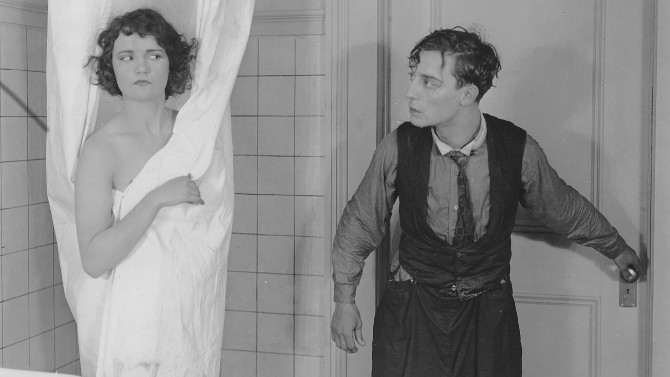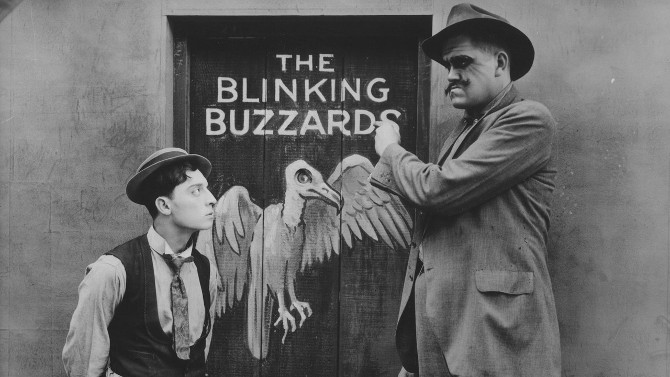The triumvirate of silent era comedians, in no particular order, are as follows: the ever famous Charlie Chaplin, the oft forgotten Harold Lloyd and ‘The Great Stone Face’ Buster Keaton. As I have already reviewed a film of Lloyd’s and several of Chaplin’s, I thought it would be a good time to visit some of the work of Keaton’s acrobatic and stoic-faced silent era screen personas. To change things up a tad, I also thought it would be fun to look to some of his earlier short films instead of his more iconic full length features like The General.
In the early 1920’s, Keaton created 19 short films after making a name for himself in the late 1910’s co-starring in movies with the now infamous Fatty Arbuckle. Keaton, like Chaplin and Lloyd, had the unbelievable ability of being limber and acrobatic, making him a supremely talented physical comic.
Keaton’s first short film to be released was 1920’s One Week, which he wrote and directed with the help of Eddie Cline. The comedian stars as The Groom, who has just married his beloved wife, simply known as The Bride (Sybil Seely). The two, who are being chauffeured by a man who was also vying for the love of The Bride, are handed a letter that explains that the couple have been gifted a property and home by The Groom’s uncle. When they arrive at the location (after dealing with some issues from the embittered driver), they realize that there is no home, but rather, a ‘build it yourself’ house kit (something quite common at the time). From a modern perspective, what ensues is akin to the nightmarish prospect of one assembling an entire home from Ikea (and they do not even supply that frustrating yet helpful hex/allen key). The man puts on a brave face, showing that he is up for the job (though he is clearly not). With some more interference from the intrusive former suitor, who changes the numbers on the supply boxes, The Groom’s instructions lead him to a disastrous path – leaving him with a home that resembles something out of a Salvador Dali nightmare.
The twosome eventually discover that they have built their home on the wrong lot – confusing 99 and 66) and they must move the rickety abode in the most unorthodox of ways.
Known as one of the great shorts from Keaton, One Week demonstrates the skilful bumbling of the comedic master, as well as a number of his iconic and daring set pieces. We see him straddle two moving cars with the wedding vehicle holding a sign that funnily says “Good luck. You’ll need it” – great advice for the daring stunt and for a married couple of that time or this. Another example is him falling out of a second story door (clearly this was up to code back in the day). A standout scene has a full wall of a house fall around him – with him safely making his way through the window hole (a famed stunt that has been recreated numerous times, including in a future Keaton project), as well as a classic scene with a piano and his precarious manoeuvring on a ladder (that he retrieves from a funny location). The scope is also impressive, for when the house spins or a train motors by, these things are actually happening – they are not done with miniature models.
These stunts, which still baffle the mind today, and we must not forget that Keaton was really doing these things, show the far reaching effects of this silent era mastermind. When we watch the ladder scene mentioned above, all that we can see is reckless father and husband Clark W. Griswold in Christmas Vacation trying to decorate his house for the holidays. His flips, jumps and falls foreshadow the likes of Chris Farley, Jim Carrey, Rowan Atkinson or numerous other physically gifted individuals.
There is also a tantalising little scene of his wife in the bathtub. As we watch her, she drops her soap –forcing her to reveal herself as she fetches it. As this is about to happen, a hand covers the camera, continuing the frustratingly risque tease.
Though this was the first film he released, it was not the first that he made. That honour falls to The ‘High Sign’, a movie that Keaton was not perfectly satisfied with. He shelved it for a year until an injury forced him to release it while he recovered in 1921.
In it, Keaton stars as Our Hero, a vagabond drifter who is looking for a job. He reads that there is an opening for a professional gunman at a carnival-type shooting gallery. After stealing a firearm from an unaware police officer and replacing it with a banana (a gag that will come back into play later in the short), he takes a try at shooting for the first time. Though he seems to aim straight, he is always off target. Undeterred, he rigs the shooting gallery in a clever way that I will not spoil, so that he can ring the bell every time he fires the gun – making it seem as though he is actually hitting a target. This semblance of proficiency gets him hired as a bodyguard by a father and daughter – as the gentleman is being threatened by a gang known as the Blinking Buzzards. Unbeknownst to Our Hero, the gallery is being run by the group of thugs – and in a clever twist, they hire the sharpshooter to kill the same man that he has been hired to protect. The finale takes us to the threatened man’s home, which he has retrofitted with booby traps and secret doors, and we gleefully watch as Keaton tries to make sense of the conundrum that he has found himself in.
There are many things to highlight in this flick – which feels somewhat like a cross between a Loony Tunes episode and Home Alone. We witness a take on the old slippery banana peel gag (which was popular in both Vaudeville and silent comedies of this era), yet in a clever bit of trickery, no one falls on it. There is also a confounding visual illusion where Keaton paints a hat hook on the wall, only to be able to use it for said hat. But what truly makes this film is the big finale. The impressive setting and complex actions are sure to amaze (and may shock some – as this comedy is quite a bit more violent than what would be expected). Sometimes, as many as four rooms are shown on screen at once, displaying the agile escape tactics of Our Hero. He is seen climbing a lattice, swinging from the eaves, using a hidden rotating door to dodge the villains (something used in a number of action, horror and comedy films – i.e. the rotating fireplace in Indiana Jones and the Last Crusade or the rotating wall in Abbott and Costello Meet Frankenstein being just two examples), and jumping through a picture frame.
By way of these two little known silent films, one can see the unfathomable talent of the iconic Buster Keaton. He has perfect timing and unbelievable physical manoeuverability that is able to mesmerize us at every one of his many twists and turns. It is a godsend that these historic gems have survived nearly one hundred years so that we too can enjoy this man’s comedic gifts, while also allowing us to draw parallels and connections to how comedy movies have been influenced by these past ventures. So, take a leap a faith and watch these two classic shorts, for they’re tall on laughs.
Both motion pictures can be found on Youtube. Click on the links to enjoy these two movies. https://youtu.be/eiLzoB-9RZg https://youtu.be/hyLM-y3O9XY


